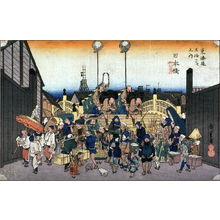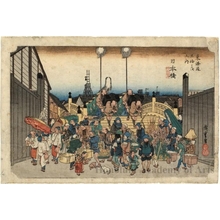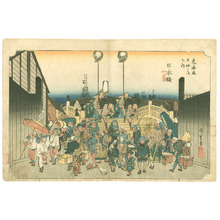Utagawa Hiroshige创作的日本版画《Processional Standard- Bearers at Nihonbashi Bridge (Station #1)》
标题:Processional Standard- Bearers at Nihonbashi Bridge (Station #1)
日期:c. 1833 - 1834
详情:更多信息...
来源:Honolulu Museum of Art
浏览所有5,476幅版画...
描述:
This is perhaps the most symbolic of the prints in reflecting the energy, variety, and magnitude of the thriving commoner class in the late Edo period. The scene is the famous Nihon Bridge in early morning. The dark silhouette of the city roofs of merchants' stores, warehouses, and homes spreads under a hint of morning blue. Crossing the bridge, a daimyo's procession, just beginning its journey out of Edo, is led by minor retainers in identical green haori, blue hakama, and tan sugegasa, who march in unison. Leading the procession, pair of standard-bearers and two porters also advance forward in harmony. Moving out of the background, the small, rigid figures in the samurai procession march straight into a bustling crowd of commoners. In every direction, men, women, children, and even puppies fill the broad street at the foot of the bridge. Intent on their own business, they ignore the approaching samurai. Hiroshige depicts commoners whose independence, self-assurance, and sheer vitality oppose and overwhelm the marching samurai. Peddlers carrying their wares on shoulder poles wear functional hanten (short-sleeved open jacket) with tenugui (towels) tied around their heads. A fishmonger balances a round shallow tray of fish on his head. A man by the gate at the right can barely be seen beneath his huge bundle partially wrapped in a green cloth. To his left, another man is virtually hidden amid a large display of pine branches and plum blossoms. Facing us directly is a man wearing a brown striped vest over a tucked-up dark blue kimono, tight tan leggings, straw sandals, and an indigo-blue head cloth, and at his chest a bundle hangs in a blue furoshiki. At the center, two sophisticated town women, kimonos lifted for walking, take a stroll in wooden geta. They wear large head cloths (okosozukin) that protect them from the morning chill. At the far right, a monk in simple brown garb passes the gate, avoiding the crowd, his face hidden under a peaked sedge hat. At the left, four dancers and singers appear to be engaged in a casual performance. They are dressed in white kimonos and red aprons and carry a large red umbrella, identifying them as traveling performers associated with Sumiyoshi Shrine in Osaka. The garments the people wear, the women's head cloths, and the plum blossoms and pine branches all suggest it is winter, perhaps the New Year season. The print wonderfully conveys the varied and active lives of the common people in Edo. (from “Blue and White” textiles exhibition 8/28/2008-)














![Nihonbashi [2nd edition] Ando Hiroshige, 歌川広重 (Andō Hiroshige)创作的日本版画《Nihonbashi [2nd edition]》](https://data.ukiyo-e.org/loc/thumbs/02109v.jpg)